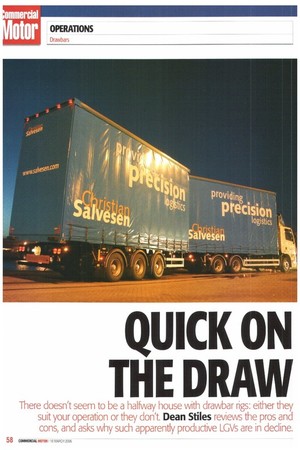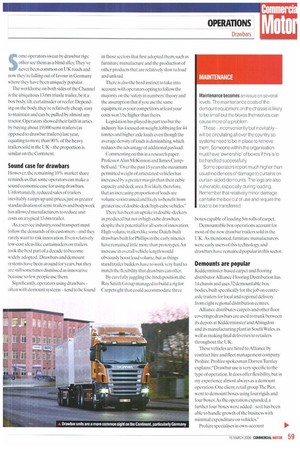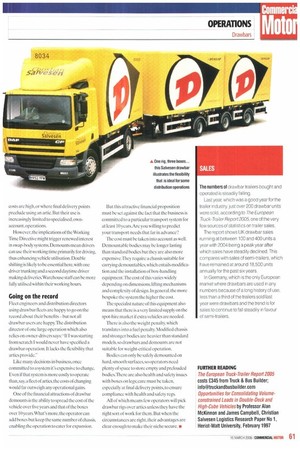QUICK ON THE DRAIN
Page 58

Page 59

Page 60

Page 61

If you've noticed an error in this article please click here to report it so we can fix it.
There doesn't seem to be a halfway house with drawbar rigs: either they suit your operation or they don't. Dean Stiles reviews the pros and cons, and asks why such apparently productive LGVs are in decline.
Some operators swear by drawbar rigs; other see them as a blind alley.They've never been common on UK roads and now they're falling out of favour in Germany where they have been uniquely popular.
The workhorse on both sides of the Channel is the ubiquitous 13.6m triaxle trailer, be it a box body, tilt, curtainsider or reefer. Depending on the body, they're relatively cheap, easy to maintain and can be pulled by almost any tractor. Operators showed their faith in artics by buying about 19,00C semi-trailers (as opposed to drawbar trailers) last year, equating to more than 90% of the heavy trailers sold in the UK -the proportion is similar on the Continent.
Sound case for drawbars
However, the remaining 10% market share reminds us that some operators can make a sound economic case for using drawbars. Unfortunately reduced sales of trailers inevitably ramps up unit prices, just as greater standardisation of semi-trailers and bodywork has allowed manufacturers to reduce unit costs on atypical 13.6m trailer.
As a service industry, road transport must follow the demands of its customersand they rarely want to risk innovation. Even relatively low-cost ideas like curtainsiders on trailers took the best part of a decade to become widely adopted. Drawbars and demount systems have been around for years, but they are still sometimes dismissed as innovative because so few people use them.
Significantly, operators using drawbarsoften with demount systems -tend to be found in those sectors that first adopted them, such as furniture manufacture and the production of other products that are relatively slow to load and unload.
There is also the herd instinct to take into account, with operators opting to follow the majority on the 'safety in numbers' theory and the assumption that if you use the same equipment as your competitors at least your costs won't be higher than theirs.
Legislation has played its part too but the industry has focused on weight, lobbying for 44 tonnes and higher axle loads even though the average density of loads is diminishing, which reduces the advantage of additional payload.
Commenting on this in a research paper, Professor Alan McKinnon and James Campbell said:"Over the past 15 years the maximum permitted weight of articulated vehicles has increased by a greater margin than their cubic capacity and deck area. It is likely therefore. that an increasing proportion of loads are volume-constrained and likely to benefit from greater use of double-deckTh i gh-cube vehicles."
There has been an uptake in double-deckers as predicted but not in high-cube drawbars. despite their potential for all sorts of innovation. High-volume trailers like some Dutch-built drawbars built for Phillips in the early nineties have remained little more than prototypes. An increase in overall vehicle length would obviously boost load volume, but as things stand trailer builders have to work very hard to match the flexibility that drawbars can offer.
By carefully juggling the hitch position. the Ray Smith Group managed to build a rig for Carpetright that could accommodate three boxes capable of loading5m rolls of carpet.
Demountable box operations account for most of the new drawbar trailers sold in the UK. As mentioned, furniture manufacturers were early users of this technology, and drawbars have remained popular in this sector.
Dernounts are popular
Kidderminster-based carpet and flooring distributor Alliance Flooring Distribution has 14 chassis and uses 32 demountable box bodies, built specifically for the job on centreaxle trailers for local and regional delivery from eight regional distribution centres.
Alliance distributes carpets and other floor coverings: drawbars are used to trunk between its depots at Kidderminster and Abingdon and its manufacturing plant in South Wales, as well as making final deliveries to retailers throughout the UK.
These vehicles are hired to Alliance by contract hire and fleet management company Prohire. Prohire spokesman Darren Turnley explains:"Drawbar use is very specific to the type of operation. It does offer flexibility, but in my experience almost always as a demount operation. One client, retail group The Pier, went to demount boxes using four rigids and four boxes. As the operation expanded, a further four boxes were addedso it has been able to handle growth of the business with minimal expenditure on vehicles, Prohire specialises in own-account operators and manages a fleet of more than 1,100 vehicles hut drawbars account for less than 5% of its fleet and those are all demount systems. "Often there is a funding issue,says Turnley."Operators will fund the chassis over five years and the boxes over 10 years.
-But it is very rare for us to recommend a drawbar operation. Customers usually have a clear idea of what system they want to run and we supply equipment."
Trunking large loads
Operators making home deliveries are turning to drawbars because they allow them to trunk large loads to urban areas then split the rigs and use the prime movers,sometimes7.5-tonners, for the local delivery work.
B&Q has saved £225,000 a year by switching to demounts for home delivery of kitchen units, appliances and fitted bedroom furniture. Its hub-and-spoke operation is based on a distribution centre in Burton on Trent which feeds 10 depots throughout the country.These act as drop-off points, with two staff each to handle deliveries.
The drawbars trunk at night and make final deliveries without the trailers during the day The bodies are loaded at the hub where all stock is kept. Chassis are allocated to each base, which is responsible for their maintenance.
Some older stores in the John Lewis Partnership chain lacked the space to accommodate artics so the firm resorted to small drawbars with demount boxes.To supply the Reading store,for example,stock is delivered from central warehouses to a service building in Theale, some five miles away Two 12-tonners run a shuttle service to the store, with a third making special runs for collection work.
It is estimated that using demounts reduced the number of chassis required from six to three, saving £38,000 a year in vehicle rental and another £35,000 by the more efficient use of drivers.
The appeal of demounts for own-account operators extends to the potential to cut warehousing costs, especially in terms of wages: fewer staff are needed at satellite drop-off depots because the bodies are preloaded.
The swap body can also act as a mobile warehouse, enabling better planning of warehouse workers' workload. And those workers can also be loading boxes while vehicles are out on the road.
Drawbar demount operations tend to be of the greatest benefit to those operations with time-constrained fleets, where warehouse
costs are high, or where final delivery points preclude using an artic. But their use is increasingly limited to specialised, ownaccount, operations.
However, the implications of the Working Time Directive might trigger renewed interest in swap-body systems. Demounts mean drivers can use their working time primarily for driving, thus enhancing vehicle utilisation. Double shifting is likely to be essential here,with one driver trunking and a second daytime driver making deliveries.Warehouse staff can be more fully utilised within their working hours.
Going on the record
Fleet engineers and distribution directors using drawbar fleets are happy to go on the record about their benefits — but not all drawbar users are happy.The distribution director of one large operation which also relies on owner-drivers says:"If was starting from scratch I would never have specified a drawbar operation. It lacks the flexibility that artics provide."
Like many decisions in business,once committed to a system it's expensive to change. Even if that system is more costly to operate than, say, a fleet of artics, the costs of changing would far outweigh any operational gains.
One of the financial attractions of drawbar demounts is the ability to spread the cost of the vehicle over five years and that of the boxes over 10 years. What's more, the operator can add boxes hut keep the same number of chassis, enabling the operation to cater for expansion. But this attractive financial proposition must be set against the fact that the business is committed to a particular transport system for at least 10 years. Are you willing to predict your transport needs that far in advance?
The cost must be taken into account as well. Demountable bodies may be longer lasting than standard bodies but they are also more expensive.They require a chassis suitable for carrying demountables. which entails modification and the installation of box-handling equipment .The cost of this varies widely depending on dimensions, lifting mechanisms and complexity of design. In general. the more bespoke the system the higher the cost.
The specialist nature of this equipment also means that there is a very limited supply on the spot-hire market if extra vehicles are needed.
There is also the weight penalty, which translates into a fuel penalty. Modified chassis and stronger bodies are heavier than standard models, so drawbars and demounts are not suitable for weight-critical operation.
Bodies can only be safely demounted on hard, smooth surfaces, so operators need plenty of space to store empty and preloaded bodics.There are also health and safety issues with boxes on legs; care must be taken, especially at final delivery points, to ensure compliance with health and safety regs.
All of which means few operators will pick drawbar rigs over artics unless they have the right sort of work for them. But when the circumstances are right, their advantages are clear enough to make their niche secure. •
































































































































































































